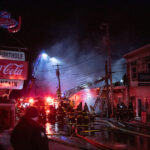A coalition of Colorado health care providers says state hospitals are losing more than $80 million a year in revenue as a result of changes to the state’s auto insurance system.
“The actual losses are probably closer to $100 million if you include all providers,” said Dr. Andrew Berson, assistant medical director for trauma services at Memorial Hospital. “If nothing is changed, it will create a crisis in the statewide trauma care system.”
Colorado in 2003 switched from a system in which all drivers were required to have coverage for treatment of any injuries resulting from auto accidents to a system in which just the driver at fault pays.
A study released July 13 by hospitals, doctors and ambulance providers said the cost of that change to care providers has been substantial—even without taking into account revenue losses from treatment of the uninsured.
Memorial and Penrose-St. Francis Health Services in Colorado Springs estimated earlier this year the new insurance system had cost $4.5 million in losses on treatment of auto accident victims.
Insurance industry officials say the switch away from the no-fault system has saved Colorado drivers by dropping coverage most didn’t need.
“People who drive cars paid a disproportionate share of the costs under the previous system,” said Carole Walker, executive director of the Rocky Mountain Insurance Information Association.
“We don’t believe people should be required to have medical coverage as part of their auto insurance just because some people don’t have health insurance,” Walker told The Gazette. “Hospital profits are at the highest level in years, and many hospitals are building big new facilities.”
Bradd Hafer, a Memorial Hospital spokesman, said the losses the hospital suffers on auto accident victims “must be recovered from people who can pay for their own health care.”
The coalition’s study said the percentage of accident patients covered by auto insurance fell from 55.6 percent in 2001 to 32 percent last year; the percentage not paying for their care rose from 1.4 percent to 6.7 percent during the same period.
The study also said the percentage of patients who couldn’t pay for ambulance services had more than doubled to 43.4 percent from 2001 to 2004.
Copyright 2005 Associated Press. All rights reserved. This material may not be published, broadcast, rewritten or redistributed.
Topics Auto
Was this article valuable?
Here are more articles you may enjoy.


 Fire Damages Portland, Maine’s Historic Waterfront
Fire Damages Portland, Maine’s Historic Waterfront  Longtime Motel 6 Spokesman Tom Bodett Settles Lawsuit Against Chain
Longtime Motel 6 Spokesman Tom Bodett Settles Lawsuit Against Chain  Judge Green Lights New York’s Driver’s License Law, Rejecting Trump Challenge
Judge Green Lights New York’s Driver’s License Law, Rejecting Trump Challenge  Howden US Tells Judge Brown & Brown Employees Fled Due to ‘Mistreatment’
Howden US Tells Judge Brown & Brown Employees Fled Due to ‘Mistreatment’ 

